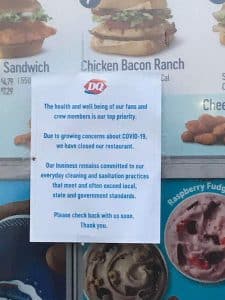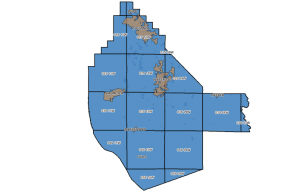Six new coronavirus cases reported in Monroe County
Monroe County reported six new COVID-19 cases between Monday and Tuesday, bringing the overall total to 115.
Monroe County Health Department Administrator John Wagner said two of the new cases are family members of a known positive. Two new cases live with someone who has tested positive. The other new cases involve someone who had close contact with a known positive and someone associated with an outbreak at a medical facility in St. Louis.
The Waterloo Dairy Queen closed for cleaning last week after one of its employees tested positive for COVID-19.

Wagner said there is “very low risk” to the public that went through the drive-thru of the fast food restaurant in recent days.
There are at least 39 active cases in Monroe County, including seven hospitalizations. Wagner said 62 positive cases have fully recovered. The local death toll due to COVID-19 remains at 12.
All staff and residents at Oak Hill Senior Living and Rehabilitation Center in Waterloo were tested for COVID-19 last Friday.
The facility received results from the approximately 400 tests Tuesday, and three employees tested positive.
The positive employees were all asymptomatic but were sent home, Oak Hill administrator Kim Keckritz said, adding that two of the three are part-time employees and none live in Monroe County. This is in addition to three earlier employees who tested positive.
No Oak Hill residents have tested positive.
Another facility-wide test will be conducted June 26.
According to the IDPH, the Waterloo zip code has had 58 confirmed cases (860 tests), the Columbia zip code has had 48 cases (273 tests) and the Valmeyer zip code has had 11 cases (50 tests).
To the north, St. Clair County has 1,837 confirmed cases, including 135 coronavirus-related deaths. A total of 13,868 people have been tested there.
In nearby Randolph County, there have been 279 confirmed cases, none of which are active. Seven people have died from the virus, 272 have recovered and none are hospitalized with it in that county.
The virus appears to still be slowing across the region.
In the southern region of the state, there is a positivity rate of 3 percent, a 0 percent decrease in positivity rates and a 52 percent drop in hospital admissions for coronavirus-like illnesses in the last 14-28 days.
The region also has a 44 percent medical and surgical bed capacity, 53 percent ICU bed availability and 76 percent ventilator availability.
To move to the next phase, a region must have a test positive rate under 20 percent that is increasing by no more than 10 percentage points over 14 days, no overall increase in hospital admissions for COVID-19-like illnesses for 28 days and surge capacity of at least 14 percent for ICU, medical and surgical beds and ventilators.
A region must be also able to test anyone regardless of symptoms or risk factors and have contact tracing and monitoring begin within 24 hours of diagnosis for more than 90 percent of cases.
There are 137,825 cases of coronavirus and 6,707 deaths in Illinois, according to the IDPH.
The state announced 601 new cases and 38 new deaths on Tuesday. There were 462 additional cases and 26 additional deaths on Monday. There were 658 more cases and 23 more deaths on Sunday. There were 634 new cases and 45 new deaths on Saturday. There were 692 additional cases and 44 additional deaths on Friday. There were 593 more cases and 55 more deaths on Thursday. There were 546 new cases and 87 new deaths on Wednesday.
In Missouri, there were 18,577 confirmed cases and 966 deaths as of Tuesday. That includes 5,606 cases in St. Louis County and 2,142 cases in St. Louis City, according to the Missouri Department of Health & Senior Services.
Nationally, more than 2,337,456 people had contracted the virus, while 120,838 people have died.
Worldwide, there are over 9.1 million cases of coronavirus and at least 473,392 COVID-19-related deaths.
As the southern region of Illinois as defined in the state’s reopening plan looks to move to Phase 4 this Friday, one of the critical components is contact tracing.
To move to this next phase, a region must be able to begin contact tracing and monitoring within 24 hours for 90 percent of coronavirus cases.
Wagner told the Republic-Times that, aside from being crucial to getting closer to normal life, the process of tracking everyone who a person with coronavirus was in contact with prior to the onset of symptoms is important for public health reasons.
“We need to make sure we go out and get those people quarantined so they do not continue to pass it unknowingly,” Wagner said of those who have had close contact with someone who has COVID-19. “We need to make sure we get it shut down quick so we don’t have a long string of them.”
Wagner noted that people who have the coronavirus are contagious before they test positive or start showing symptoms, which means individuals who contract the virus must remember those who they have had close contact with in the last 10-14 days.
Close contact in this case means 15 or more minutes of interaction.
Once the health department learns someone in the county tests positive, one of the department’s employees calls that person and asks them when their symptoms began and who they had been in close contact with starting with two days before they began experiencing symptoms.
The contact tracer then asks for contact information for all those people, who they call and tell to self-quarantine for 14 days. If those individuals experience no symptoms after 14 days – the incubation period for the virus – they are released from quarantine.
The person who has the virus, meanwhile, must report their temperature to the health department twice a day.
If contact cannot be made over the phone at any point in this process, a health department employee will go to the person’s house.
Wagner said everyone in his department helps with contact tracing, though two of his staff are leading the way, working 12-14-hour days sometimes.
“Everybody’s just pitching in and doing it,” Wagner said. “Right now, we’re about at our capacity. We’re averaging 5-10 cases a week, and that’s about what we can handle without bringing in new personnel to help with the contact tracing.”
Monroe County has been contact tracing since the start of the pandemic, completing that process with about 400 people so far.
Wagner said his department may need to hire more people to help with that task if the county sees a jump in cases, but so far it has gone extremely well.
“We’ve contact traced 100 percent of our known positives,” Wagner said, noting the department could not trace where people got the virus in only a few cases. “We’ve had great cooperation from the public. We’ve pretty much been able to track all of our positives back to where they got it because we’re not having these long spreads of unknown cases.”
“People are going to get this, and it’s nothing against the person who got it,” Wagner added. “Who knows what you can pick it up off of? We just need to stop it with that person.”
So far, at least in Monroe County, it appears people who have the closet contact with someone with the virus are the ones who contract it, though Wagner cautioned that does not mean others are not at risk.
“We’re seeing very few cases outside of what I’d call ‘ultra-close contact,’ when you live with somebody or work eight hours a day in a closed office,” Wagner explained. “From what I’m seeing, the close contacts seem to be at a very low risk. But obviously, at least one or two would be enough to cause a big outbreak if you let those people continue to migrate through society.”
While it has been a success here overall, contact tracing has not been without its challenges – such as people pushing back due to privacy concerns or giving incorrect addresses or phone numbers on forms when they get tested.
That latter problem has not arisen much here, but Wagner said the worst issue has been misinformation from Monroe County and other counties.
Oftentimes, that comes from counties losing track of the latest guidelines from the state, which Wagner said have been revised countless times.
“One county may be telling someone ‘you need to quarantine for 10 days.’ And this other county is telling them, ‘you need to quarantine for 14 days,” Wagner gave as an example. “As soon as people get misinformation, that’s when they start to question what we’re doing.”
Wagner said the counties in this area are working to develop a consensus plan to minimize these issues.
Looking at the region as a whole, Wagner said counties with more positive cases have had more problems.
“Randolph County had a little bit of an issue when they had an outbreak at Gilster-Mary Lee,” he said. “That gave them a surge of cases that was difficult to keep tabs on. But it’s improved down there since the outbreak.”
Jackson County, which is home to Carbondale, has had over 300 cases, but Wagner said he was unaware of any problems with contact tracing there.
He said St. Clair County, with its over 1,500 cases, has. That county could initially only trace “ultra-close contacts” due to its limited workforce, but it is now one of two counties in a pilot program for contact tracing the state has arranged.
If that is successful and there are no large outbreaks in cities like Carbondale, Wagner said he believed the southern region could meet the contact tracing requirement to move to Phase 4 by the end of the month.
“Anytime you’re lumped in with one of the bigger cities, you can have issues hitting that number,” he said. “Pretty much every county south of St. Clair is hitting those numbers.”
If that trend continues, moving to the next phase will be a matter of keeping cases low, hospital capacity high and increasing testing.






